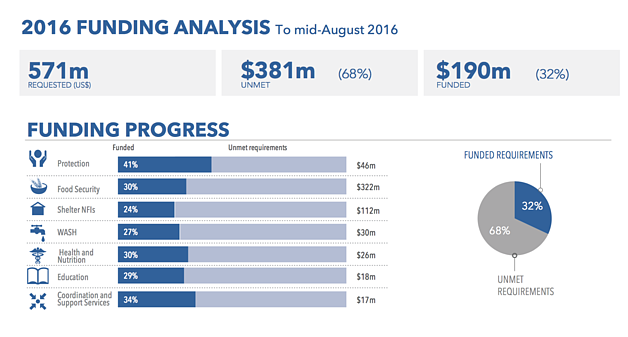This year’s Humanitarian Response Plan seriously underfunded, impacting critical interventions
As of mid-August, the 2016 Humanitarian Response Plan (HRP) for the OPT was severely underfunded in both percentage terms (32 vs. 50) and in absolute terms (US $183 vs. $355 million) compared to the 2015 HRP. Almost 90 per cent of the funds received have gone to UN agencies, leaving INGO and local NGO projects substantially underfunded. This can be attributed, at least in part, to a global economic slowdown and to a number of major crises, particularly in the Middle East, which have put humanitarian budgets under increased pressure.
Although the OPT HRP shares many of the features of other operations around the world, the context of the OPT is unique - a protracted protection crisis that stems from the impact of a military occupation now in its 50th year. The HRP was launched locally in February and plans to support one in three Palestinians with some form of humanitarian assistance in 2016.[1] It includes 206 projects worth $571 million, 19 per cent lower than the sum requested in 2015. Seventy-nine organizations are participating: 12 UN agencies, 36 international NGOs and 31 national NGOs. Approximately one-third of funds requested are designated as “top priority” to target where limited resources should be allocated first. Over 65 per cent of the funding requirement is for Gaza. Gender has been mainstreamed throughout all HRP objectives and cluster strategies to ensure the protection of all members of the affected population, and to guarantee effective and equitable delivery of humanitarian assistance.
Top priority projects particularly affected
Only 16 per cent of the funds requested for top priority projects have been received. None of the projects funded so far in the Education Cluster address top priority activities. Likewise, no funding has been received by the Health and Nutrition Cluster for key interventions aimed at providing access to essential health-care services to some one million people across the OPT. In the Shelter and NFI Cluster, the response to demolitions of agricultural structures - designated as a top humanitarian priority - remains unfunded, endangering vulnerable households in Area C.

In percentage terms, the Shelter Cluster is currently the least funded (22 per cent), having received $27 million, leaving a funding gap of $85 million. The Food Security Sector (FSS) has received most funds in absolute terms ($97 million). Nevertheless, the funding gap remains high, especially for agricultural and livelihood support activities, and $224 million are still required to implement food security activities for the rest of the year. The overall impact of the funding shortfall would mean failure to provide food assistance and “cash for work” to 1.4 million food-insecure Palestinians, leading to a high risk of increased food insecurity and deterioration of food consumption patterns.
Reduced funding for the OPT HRP limits the humanitarian community’s ability to implement a number of critical interventions and to respond to humanitarian needs, which remain critical. In the absence of additional pledges, organizations will be forced to scale back activities in the second half of 2016, and the impact will be felt across all humanitarian sectors in the Gaza Strip and the West Bank, including East Jerusalem.









